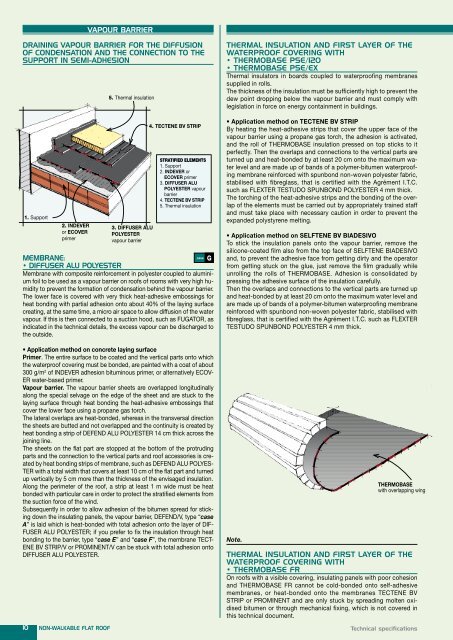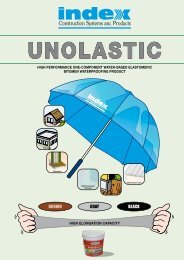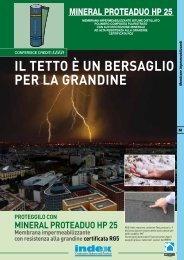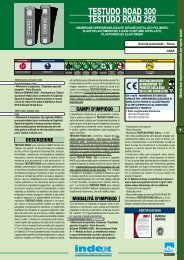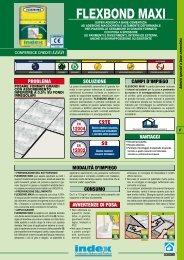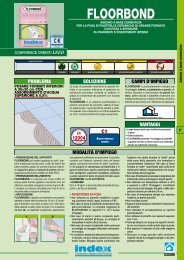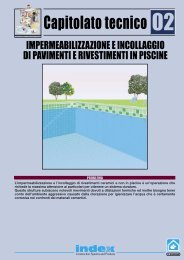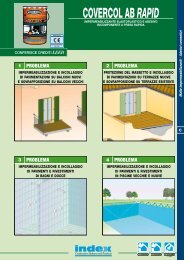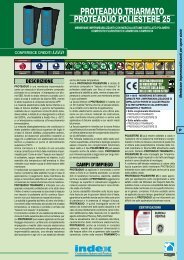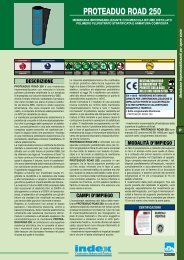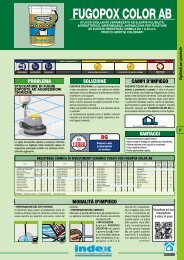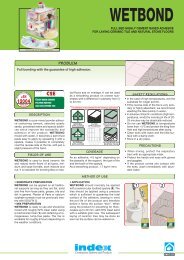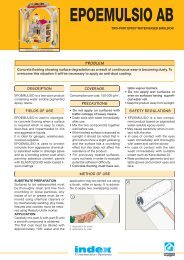Technical specification - Index S.p.A.
Technical specification - Index S.p.A.
Technical specification - Index S.p.A.
Create successful ePaper yourself
Turn your PDF publications into a flip-book with our unique Google optimized e-Paper software.
VAPOUR BARRIER<br />
DRAINING VAPOUR BARRIER FOR THE DIFFUSION<br />
OF CONDENSATION AND THE CONNECTION TO THE<br />
SUPPORT IN SEMI-ADHESION<br />
1. Support<br />
2. INDEVER<br />
or ECOVER<br />
primer<br />
5. Thermal insulation<br />
3. DIFFUSER ALU<br />
POLYESTER<br />
vapour barrier<br />
4. TECTENE BV STRIP<br />
STRATIFIED ELEMENTS<br />
1. Support<br />
2. INDEVER or<br />
ECOVER primer<br />
3. DIFFUSER ALU<br />
POLYESTER vapour<br />
barrier<br />
4. TECTENE BV STRIP<br />
5. Thermal insulation<br />
MEMBRANE:<br />
case G<br />
• DIFFUSER ALU POLYESTER<br />
Membrane with composite reinforcement in polyester coupled to aluminium<br />
foil to be used as a vapour barrier on roofs of rooms with very high humidity<br />
to prevent the formation of condensation behind the vapour barrier.<br />
The lower face is covered with very thick heat-adhesive embossings for<br />
heat bonding with partial adhesion onto about 40% of the laying surface<br />
creating, at the same time, a micro air space to allow diffusion of the water<br />
vapour. If this is then connected to a suction hood, such as FUGATOR, as<br />
indicated in the technical details, the excess vapour can be discharged to<br />
the outside.<br />
• Application method on concrete laying surface<br />
Primer. The entire surface to be coated and the vertical parts onto which<br />
the waterproof covering must be bonded, are painted with a coat of about<br />
300 g/m 2 of INDEVER adhesion bituminous primer, or alternatively ECOV-<br />
ER water-based primer.<br />
Vapour barrier. The vapour barrier sheets are overlapped longitudinally<br />
along the special selvage on the edge of the sheet and are stuck to the<br />
laying surface through heat bonding the heat-adhesive embossings that<br />
cover the lower face using a propane gas torch.<br />
The lateral overlaps are heat-bonded, whereas in the transversal direction<br />
the sheets are butted and not overlapped and the continuity is created by<br />
heat bonding a strip of DEFEND ALU POLYESTER 14 cm thick across the<br />
joining line.<br />
The sheets on the flat part are stopped at the bottom of the protruding<br />
parts and the connection to the vertical parts and roof accessories is created<br />
by heat bonding strips of membrane, such as DEFEND ALU POLYES-<br />
TER with a total width that covers at least 10 cm of the flat part and turned<br />
up vertically by 5 cm more than the thickness of the envisaged insulation.<br />
Along the perimeter of the roof, a strip at least 1 m wide must be heat<br />
bonded with particular care in order to protect the stratified elements from<br />
the suction force of the wind.<br />
Subsequently in order to allow adhesion of the bitumen spread for sticking<br />
down the insulating panels, the vapour barrier, DEFEND/V, type “case<br />
A” is laid which is heat-bonded with total adhesion onto the layer of DIF-<br />
FUSER ALU POLYESTER; if you prefer to fix the insulation through heat<br />
bonding to the barrier, type “case E” and “case F”, the membrane TECT-<br />
ENE BV STRIP/V or PROMINENT/V can be stuck with total adhesion onto<br />
DIFFUSER ALU POLYESTER.<br />
THERMAL INSULATION AND FIRST LAYER OF THE<br />
WATERPROOF COVERING WITH<br />
• THERMOBASE PSE/120<br />
• THERMOBASE PSE/EX<br />
Thermal insulators in boards coupled to waterproofing membranes<br />
supplied in rolls.<br />
The thickness of the insulation must be sufficiently high to prevent the<br />
dew point dropping below the vapour barrier and must comply with<br />
legislation in force on energy containment in buildings.<br />
• Application method on TECTENE BV STRIP<br />
By heating the heat-adhesive strips that cover the upper face of the<br />
vapour barrier using a propane gas torch, the adhesion is activated,<br />
and the roll of THERMOBASE insulation pressed on top sticks to it<br />
perfectly. Then the overlaps and connections to the vertical parts are<br />
turned up and heat-bonded by at least 20 cm onto the maximum water<br />
level and are made up of bands of a polymer-bitumen waterproofing<br />
membrane reinforced with spunbond non-woven polyester fabric,<br />
stabilised with fibreglass, that is certified with the Agrément I.T.C.<br />
such as FLEXTER TESTUDO SPUNBOND POLYESTER 4 mm thick.<br />
The torching of the heat-adhesive strips and the bonding of the overlap<br />
of the elements must be carried out by appropriately trained staff<br />
and must take place with necessary caution in order to prevent the<br />
expanded polystyrene melting.<br />
• Application method on SELFTENE BV BIADESIVO<br />
To stick the insulation panels onto the vapour barrier, remove the<br />
silicone-coated film also from the top face of SELFTENE BIADESIVO<br />
and, to prevent the adhesive face from getting dirty and the operator<br />
from getting stuck on the glue, just remove the film gradually while<br />
unrolling the rolls of THERMOBASE. Adhesion is consolidated by<br />
pressing the adhesive surface of the insulation carefully.<br />
Then the overlaps and connections to the vertical parts are turned up<br />
and heat-bonded by at least 20 cm onto the maximum water level and<br />
are made up of bands of a polymer-bitumen waterproofing membrane<br />
reinforced with spunbond non-woven polyester fabric, stabilised with<br />
fibreglass, that is certified with the Agrément I.T.C. such as FLEXTER<br />
TESTUDO SPUNBOND POLYESTER 4 mm thick.<br />
THERMOBASE<br />
with overlapping wing<br />
10 NON-WALKABLE FLAT ROOF <strong>Technical</strong> <strong>specification</strong>s<br />
Note.<br />
THERMAL INSULATION AND FIRST LAYER OF THE<br />
WATERPROOF COVERING WITH<br />
• THERMOBASE FR<br />
On roofs with a visible covering, insulating panels with poor cohesion<br />
and THERMOBASE FR cannot be cold-bonded onto self-adhesive<br />
membranes, or heat-bonded onto the membranes TECTENE BV<br />
STRIP or PROMINENT and are only stuck by spreading molten oxidised<br />
bitumen or through mechanical fixing, which is not covered in<br />
this technical document.


